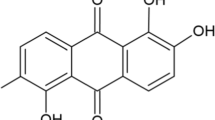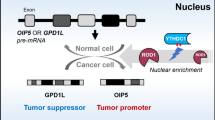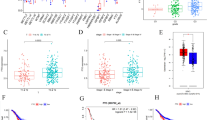Abstract
PIWI (P element induced wimpy testis) integrating RNAs (piRNAs) are small non-coding RNAs with the length of approximately 30 nucleotides that plays crucial roles in germ cells and adult stem cells. Recently, accumulating data have shown that piRNA and PIWI proteins are involved in tumorigenesis. However, the roles of PIWI proteins and piRNAs in pancreatic cancer are still elusive. Here, we showed that piR-017061 is significantly downregulated in pancreatic cancer patients’ samples and pancreatic cancer cell lines. Furthermore, we studied the function of piR-017061 in pancreatic cancer and our data revealed that piR-017061 inhibits pancreatic cancer cell growth in vitro and in vivo. Moreover, we analyzed the genomic loci around piR-017061 and identified EFNA5 as a novel target of piR-017061. Importantly, our data further revealed a direct binding between piR-017061 and EFNA5 mRNA mediated by PIWIL1. Mechanically, piR-017061 cooperates with PIWIL1 to facilitate EFNA5 mRNA degradation and loss of piR-017061 results in accumulation of EFNA5 which facilitates pancreatic cancer development. Hence, our data provided novel insights into PIWI/piRNA-mediated gene regulation and their function in pancreatic cancer. Since PIWI proteins and piRNA predominately express in germline and cancer cells, our study provided novel therapeutic strategy for pancreatic cancer treatment.







Similar content being viewed by others
References
Lau NC, et al. Characterization of the piRNA complex from rat testes. Science. 2006;313:363–7. https://doi.org/10.1126/science.1130164.
Grivna ST, Beyret E, Wang Z, Lin HF. A novel class of small RNAs in mouse spermatogenic cells. Gene Dev. 2006;20:1709–14. https://doi.org/10.1101/gad.1434406.
Grivna ST, Pyhtila B, Lin HF. MIWI associates with translational machinery and PIWI-interacting RNAs (piRNAs) in regulating spermatogenesis. Proc Natl Acad Sci U S A. 2006;103:13415–20. https://doi.org/10.1073/pnas.0605506103.
Aravin AA, Sachidanandam R, Girard A, Fejes-Toth K, Hannon GJ. Developmentally regulated piRNA clusters implicate MILI in transposon control. Science. 2007;316:744–7. https://doi.org/10.1126/science.1142612.
Yin H, Lin HF. An epigenetic activation role of Piwi and a Piwi-associated piRNA in Drosophila melanogaster. Nature. 2007;450:304-U316. https://doi.org/10.1038/nature06263.
Liu YM, et al. The emerging role of the piRNA/piwi complex in cancer. Mol Cancer. 2019. https://doi.org/10.1186/s12943-019-1052-9.
Ross RJ, Weiner MM, Lin HF. PIWI proteins and PIWI-interacting RNAs in the soma. Nature. 2014;505:353–9. https://doi.org/10.1038/nature12987.
Qiao D, Zeeman AM, Deng W, Looijenga LH, Lin HF. Molecular characterization of hiwi, a human member of the piwi gene family whose overexpression is correlated to seminomas. Oncogene. 2002;21:3988–99. https://doi.org/10.1038/sj.onc.1205505.
Liu XY, et al. Expression of hiwi gene in human gastric cancer was associated with proliferation of cancer cells. Int J Cancer. 2006;118:1922–9. https://doi.org/10.1002/ijc.21575.
Fu A, Jacobs DI, Hoffman AE, Zheng TZ, Zhu Y. PIWI-interacting RNA 021285 is involved in breast tumorigenesis possibly by remodeling the cancer epigenome. Carcinogenesis. 2015;36:1094–102. https://doi.org/10.1093/carcin/bgv105.
Tan LP, et al. PIWI-interacting RNA-36712 restrains breast cancer progression and chemoresistance by interaction with SEPW1 pseudogene SEPW1P RNA. Mol Cancer. 2019. https://doi.org/10.1186/s12943-019-0940-3.
Krishnan P, et al. Piwi-interacting RNAs and PIWI genes as novel prognostic markers for breast cancer. Oncotarget. 2016;7:37944–56. https://doi.org/10.18632/oncotarget.9272.
Mai DM, et al. PIWI-interacting RNA-54265 is oncogenic and a potential therapeutic target in colorectal adenocarcinoma. Theranostics. 2018;8:5213–30. https://doi.org/10.7150/thno.28001.
Qu AL, et al. A serum piRNA signature as promising non-invasive diagnostic and prognostic biomarkers for colorectal cancer. Cancer Manag Res. 2019;11:3703–20. https://doi.org/10.2147/Cmar.S193266.
Cordeiro A, et al. PiwiRNA-651 as marker of treatment response and survival in classical Hodgkin lymphoma. Oncotarget. 2016;7:46002–13. https://doi.org/10.18632/oncotarget.10015.
Yan H, et al. piRNA-823 contributes to tumorigenesis by regulating de novo DNA methylation and angiogenesis in multiple myeloma. Leukemia. 2015;29:196–206. https://doi.org/10.1038/leu.2014.135.
Li BB, et al. piRNA-823 delivered by multiple myeloma-derived extracellular vesicles promoted tumorigenesis through re-educating endothelial cells in the tumor environment. Oncogene. 2019a;38:5227–38. https://doi.org/10.1038/s41388-019-0788-4.
Li W, et al. The prognosis value of PIWIL1 and PIWIL2 expression in pancreatic cancer. J Clin Med. 2019b. https://doi.org/10.3390/jcm8091275.
Muller S, et al. Next-generation sequencing reveals novel differentially regulated mRNAs, lncRNAs, miRNAs, sdRNAs and a piRNA in pancreatic cancer. Mol Cancer. 2015;14:94. https://doi.org/10.1186/s12943-015-0358-5.
Buensuceso AV, et al. Ephrin-A5 is required for optimal fertility and a complete ovulatory response to gonadotropins in the female mouse. Endocrinology. 2016;157:942–55. https://doi.org/10.1210/en.2015-1216.
Wang T, Chen J, Tang CX, Zhou XY, Gao DS. Inverse expression levels of ephrinA3 and ephrinA5 contribute to dopaminergic differentiation of human SH-SY5Y cells. J Mol Neurosci. 2016;59:483–92. https://doi.org/10.1007/s12031-016-0759-y.
Zhou Y, Shiels A. Epha2 and Efna5 participate in lens cell pattern-formation. Differentiation. 2018;102:1–9. https://doi.org/10.1016/j.diff.2018.05.002.
Cao D, et al. Identification of novel highly expressed genes in pancreatic ductal adenocarcinomas through a bioinformatics analysis of expressed sequence tags. Cancer Biol Ther. 2004;3:1081–9. https://doi.org/10.4161/cbt.3.11.1175 (discussion 1090–1081).
Chen X, et al. Bcl-3 regulates TGFbeta signaling by stabilizing Smad3 during breast cancer pulmonary metastasis. Cell Death Dis. 2016;7:e2508. https://doi.org/10.1038/cddis.2016.405.
Yin J, et al. piR-823 contributes to colorectal tumorigenesis by enhancing the transcriptional activity of HSF1. Cancer Sci. 2017;108:1746–56. https://doi.org/10.1111/cas.13300.
Chen X, et al. USP17 suppresses tumorigenesis and tumor growth through deubiquitinating AEP. Int J Biol Sci. 2019;15:738–48. https://doi.org/10.7150/ijbs.30106.
Tang Z, et al. GEPIA: a web server for cancer and normal gene expression profiling and interactive analyses. Nucleic Acids Res. 2017;45:W98–102. https://doi.org/10.1093/nar/gkx247.
Ponten F. A tissue-based map of the human proteome. Scand J Immunol. 2015;81:329–329.
Siegel RL, Miller KD, Jemal A. Cancer statistics, 2019. CA Cancer J Clin. 2019;69:7–34. https://doi.org/10.3322/caac.21551.
Kelsen DP, Portenoy R, Thaler H, Tao Y, Brennan M. Pain as a predictor of outcome in patients with operable pancreatic carcinoma. Surgery. 1997;122:53–9.
Hariharan D, Saied A, Kocher HM. Analysis of mortality rates for pancreatic cancer across the world. HPB (Oxford). 2008;10:58–62. https://doi.org/10.1080/13651820701883148.
Chen Z, et al. Stem cell protein Piwil1 endowed endometrial cancer cells with stem-like properties via inducing epithelial-mesenchymal transition. BMC Cancer. 2015;15:811. https://doi.org/10.1186/s12885-015-1794-8.
Litwin M, et al. Aberrant expression of PIWIL1 and PIWIL2 and their clinical significance in ductal breast carcinoma. Anticancer Res. 2018;38:2021–30. https://doi.org/10.21873/anticanres.12441.
Xie K, et al. Cancer-testis gene PIWIL1 promotes cell proliferation, migration, and invasion in lung adenocarcinoma. Cancer Med. 2018;7:157–66. https://doi.org/10.1002/cam4.1248.
Araujo T, et al. Piwi like RNA-mediated gene silencing 1 gene as a possible major player in gastric cancer. World J Gastroenterol. 2018;24:5338–50. https://doi.org/10.3748/wjg.v24.i47.5338.
Wang C, et al. Heat shock protein DNAJA1 stabilizes PIWI proteins to support regeneration and homeostasis of planarian Schmidtea mediterranea. J Biol Chem. 2019;294:9873–87. https://doi.org/10.1074/jbc.RA118.004445.
Sun R, Gao CL, Li DH, Li BJ, Ding YH. Expression status of PIWIL1 as a prognostic marker of colorectal cancer. Dis Markers. 2017;2017:1204937. https://doi.org/10.1155/2017/1204937.
Genzor P, Cordts SC, Bokil NV, Haase AD. Aberrant expression of select piRNA-pathway genes does not reactivate piRNA silencing in cancer cells. Proc Natl Acad Sci U S A. 2019;116:11111–2. https://doi.org/10.1073/pnas.1904498116.
Shen S, et al. PIWIL1/piRNA-DQ593109 regulates the permeability of the blood-tumor barrier via the MEG3/miR-330-5p/RUNX3 axis. Mol Ther Nucleic Acids. 2018;10:412–25. https://doi.org/10.1016/j.omtn.2017.12.020.
Cheng J, et al. piR-823, a novel non-coding small RNA, demonstrates in vitro and in vivo tumor suppressive activity in human gastric cancer cells. Cancer Lett. 2012;315:12–7. https://doi.org/10.1016/j.canlet.2011.10.004.
Ai L, et al. Myeloid-derived suppressor cells endow stem-like qualities to multiple myeloma cells by inducing piRNA-823 expression and DNMT3B activation. Mol Cancer. 2019;18:88. https://doi.org/10.1186/s12943-019-1011-5.
Worku T, et al. Regulatory roles of ephrinA5 and its novel signaling pathway in mouse primary granulosa cell apoptosis and proliferation. Cell Cycle. 2018;17:892–902. https://doi.org/10.1080/15384101.2018.1456297.
Author information
Authors and Affiliations
Corresponding authors
Ethics declarations
Conflict of interest
We declare there is no conflict of interest.
Ethical approval
Involved patients were informed and all procedure related to patient samples and animals were approved by the Ethics Committee of Ruijin Hospital, Shanghai Jiaotong University School of Medicine and followed the Declaration of Helsinki. The approval number issued by the Ethics Committee of Ruijin Hospital is A-2019-016.
Additional information
Publisher's Note
Springer Nature remains neutral with regard to jurisdictional claims in published maps and institutional affiliations.
Rights and permissions
About this article
Cite this article
Xie, J., Xing, S., Shen, BY. et al. PIWIL1 interacting RNA piR-017061 inhibits pancreatic cancer growth via regulating EFNA5. Human Cell 34, 550–563 (2021). https://doi.org/10.1007/s13577-020-00463-2
Received:
Accepted:
Published:
Issue Date:
DOI: https://doi.org/10.1007/s13577-020-00463-2




